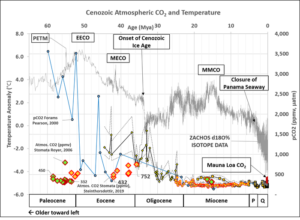by David Middleton, September 30, 2019 in WUWT
Key points
- The Eocene was, on average, 4–15 °C warmer than today.
- Atmospheric CO2 was very likely in the 450-600 ppm range.
- Modern climate models would require 4,500 ppm CO2 to simulate the Eocene temperature range;
- And/or a climate sensitivity of 4-8 °C per doubling;
- And/or “that other climate forcings were stronger than previously assumed”.
They totally missed the most obvious reason why just about every effort to gin up a paleo example of CO2-driven climate change falls apart: Atmospheric CO2 is not a primary driver of climate change over geologic time. This wouldn’t mean that it isn’t a greenhouse gas or that it has no effect on temperature. It would simply mean that it was a relatively minor climate driver, like volcanic eruptions.
At some point over the past 30 years or so, the assumption that CO2 drives modern climate change has become a paradigm. And I think we have seen a rare failure in the application of the geologic principle of Uniformitarianism.
Uniformitarianism is often incorrectly cited as the reason geologists were slow to accept plate tectonics, the impact theory of the K-Pg extinction and why the hypotheses for a Younger Dryas impact and abiotic oil are generally unaccepted. However, Uniformitarianism may be why a CO2-driven climate paradigm appears to have come into wide acceptance, at least in academia.
…

Figure 3a. Marine pCO2 (foram boron δ11B, alkenone δ13C), atmospheric CO2 from plant stomata (green and yellow diamonds with red outlines), Mauna Loa instrumental CO2 (thick red line) and Cenozoic temperature change from benthic foram δ18O (light gray line).
…
